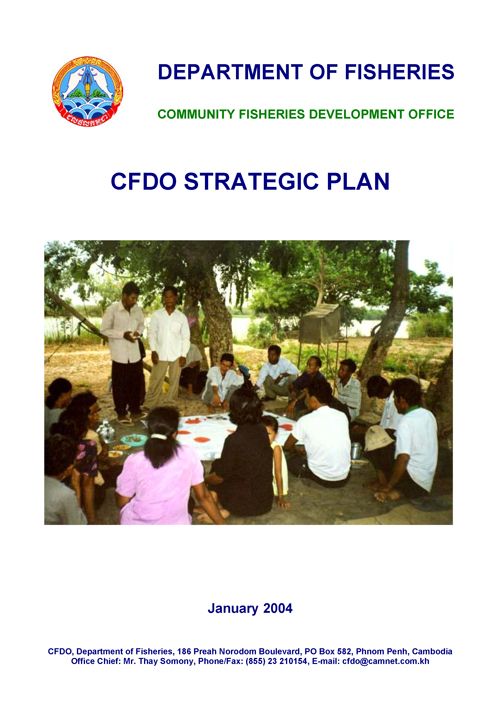Community Fisheries Development Office Strategic Plan
1 January 2004 | CFDO, Department of Fisheries | 871 Downloads | .pdf | 635.91 KB | Cambodia, Governance and Policy, Livelihoods, gender and social issues
In October 2000 the government of Cambodia announced a major change in fisheries management policy. The core elements of the new policy are the reduction of fishing lot concession areas by 56%, the broader participation of fishing communities in the management of fisheries and a focus on the efficient, sustainable and equitable use of the living aquatic resources.
The establishment of Community Fisheries throughout the country is in the process of being legalised by the approval of the Sub-decree on Community Fisheries most probably in early 2004. The sub-decree will legalise co-management arrangements between the community associations and the Department of Fisheries through the provincial offices. Each individual co-management arrangement will include the elaboration and approval of short and medium term fisheries management plans for the fishing area allocated to a particular Fishery Community.
To facilitate the establishment and development of the Community Fisheries, support and monitor their activities, the Department of Fisheries was authorised to establish a Community Fisheries Development Office (CFDO).
This document details the Strategic Plan for the CFDO in the Department of Fisheries (DoF) based on its mandate. The goals and activities described in this document do not stand on its own, but are closely linked to the goals of the DoF and other – international – organisations that are operating in Cambodian fisheries. An overview is provided below.
In April 2001 the Department of Fisheries has formulated the Master Plan for Fisheries, covering the period 2001 – 2011. The plan is still in draft and not yet fully endorsed by the Department of Fisheries. Important to note here is that the CFDO Strategic Plan and the Master Plan for Fisheries are compliant with each other.
On the regional level the CFDO is part of NACA’s STREAM Initiative, a regional communications and learning program, mandated by 15 Asia-Pacific governments and designed within the five-year work program cycle of NACA. The purpose of STREAM is to strengthen, or develop, and communicate strategies, processes and practices that enable poor and vulnerable aquatic resources users in the Asia-Pacific region to pursue their livelihood objectives. The goal of STREAM Cambodia is that poor and vulnerable aquatic resources users in Cambodia are able to achieve their livelihood objectives.
On the international level, the CFDO collaborates with various multilateral and bilateral organisations like ADB, DFID, FAO, MRC, WB and many NGO’s. Each of these organisations support the objectives for fisheries formulated by the United Nations: To promote productive, equitable and sustainable management of fishery resources which supports local community development. Development outcomes of this support are defined as follows:
- Fishery legislation and policies establishing the framework for sustainable management of the fishery resources are revised, approved and implemented.
- Local authorities and communities have the capacity to play an enhanced role in management, are contributing to its effective protection and are benefiting from its use.
- The role of fisheries in food security and in the local and national economy is enhanced.
The CFDO’s goals and activities as described in this document are consistent with the goals set forth by these organisations on their project documents on community fisheries, taking into account the fact that these organisations have a broader view of community management of natural resources world wide.
This document has been formulated by the CFDO management team with the help of their advisors (Louise Mackeson-Sandbach, Niva Gonzales and most recently Haiko Meelis) following a series of meetings listed below:
- The regular office meeting with the staff of CFDO held on June 3rd, 2003.
- The quarterly CFDO Partnership Meeting held on May 14th, 2003.
- A meeting held on January 22nd, 2003 with the office vice-chiefs to update the strategic plan.
- A meeting held on April 3rd, 2002 with the staff of CFDO to discuss and update the outputs of 2 strategic planning sessions conducted in 2001.
- Strategic Planning Workshop facilitated by the MRC in September 2001 which identified general strategies for CFDO.
- Strategic Plan developed by Mr Sten Sverdrup-Jensen (MRC) in conjunction with the CFDO office in October 2001.
This document therefore uses the previous drafts of the strategic plans as basis with revisions in certain areas and updates/amendments as agreed with the CFDO. Also, this document replaces previous versions of the CFDO Strategic Plan.
Copyright, all rights reserved.

